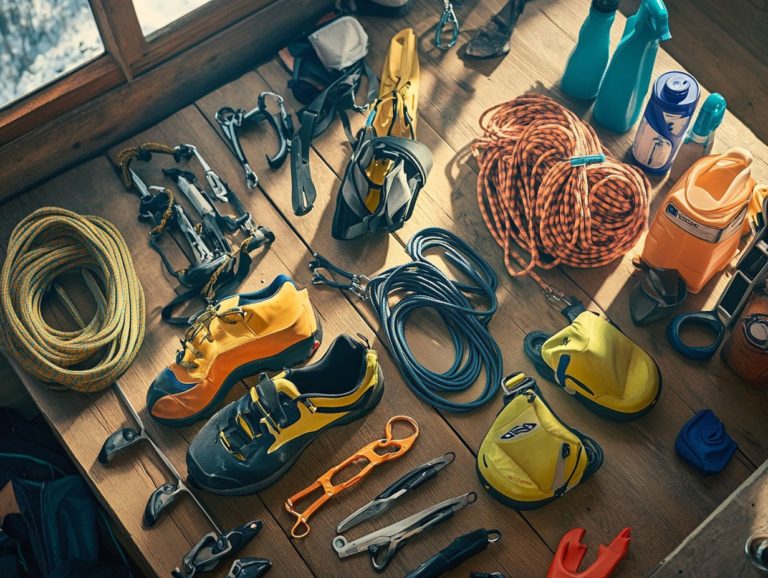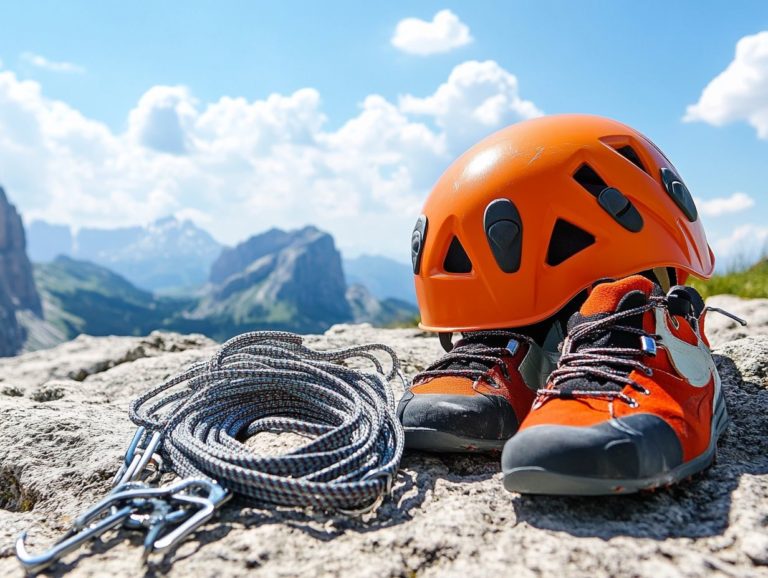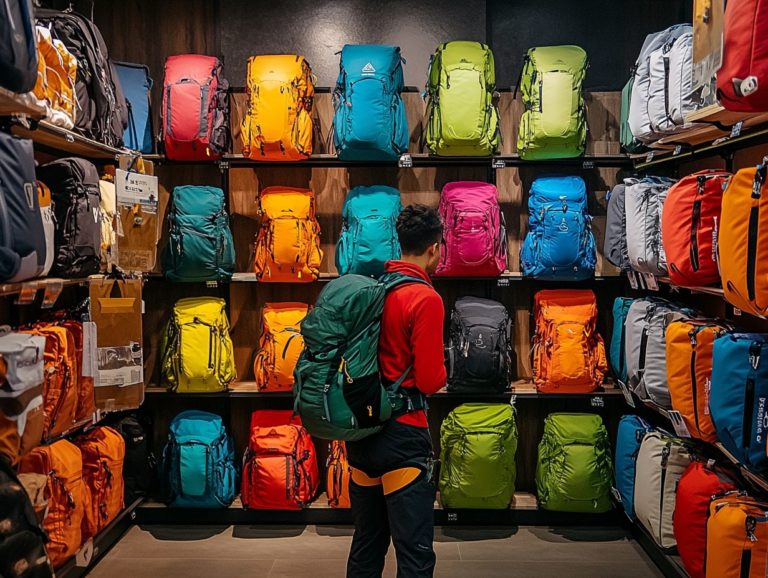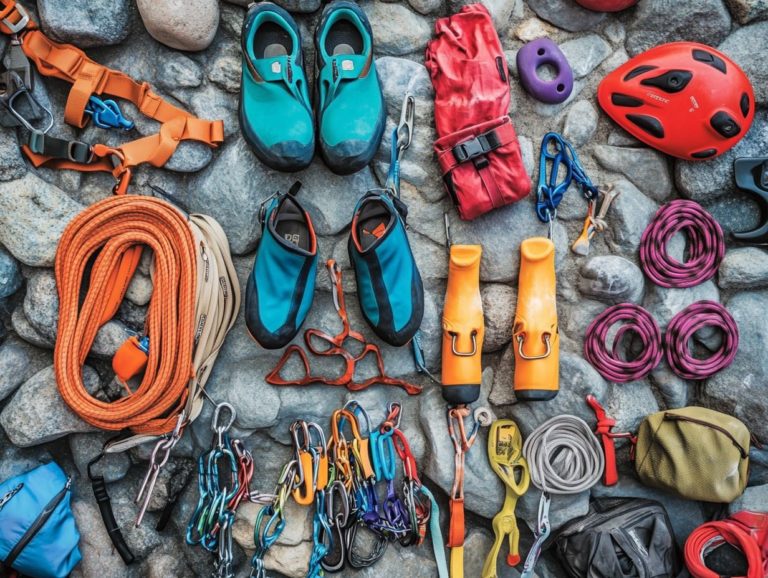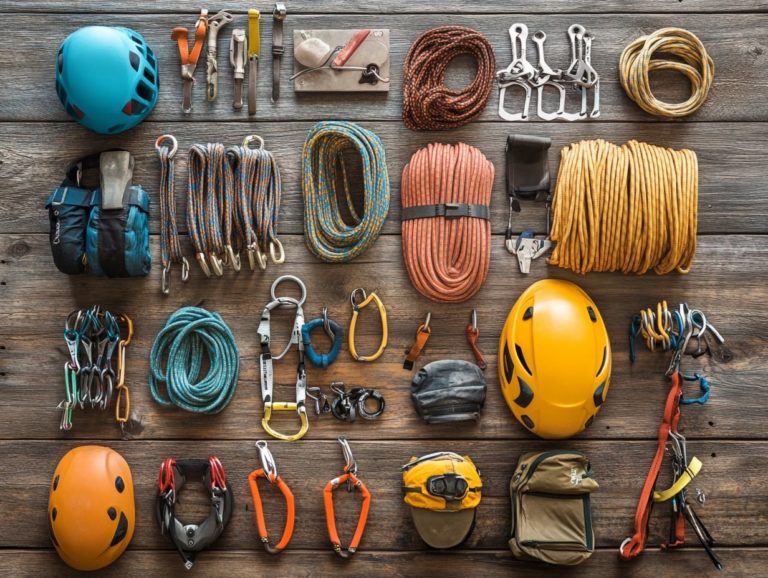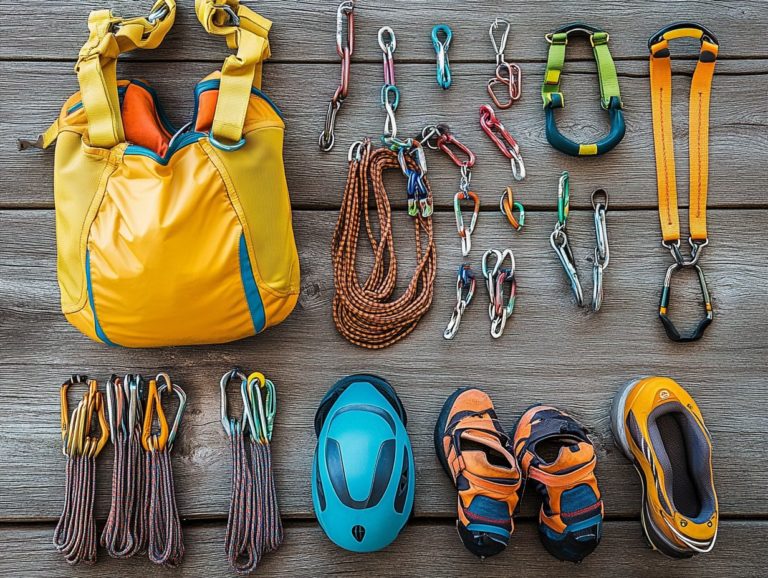Best Climbing Shoes for Beginners
Finding the right climbing shoes, especially the best beginner climbing shoes, can feel overwhelming. But choosing the right shoes can be thrilling!
With a plethora of options at your fingertips, grasping which features truly matter can dramatically enhance your climbing experience. This guide lays out the essential qualities you should consider, including climbing shoe comfort, grip, versatility, and durability.
Whether you’re gearing up for a quick indoor climbing session or preparing for an outdoor adventure, these insights will empower you to select the best climbing shoes that align with your style and elevate your confidence on the wall.
Dive in to uncover the best climbing shoes for beginners!
Contents
- Key Takeaways:
- 1. Comfort is Key
- 2. Good Grip and Traction
- 3. Versatility for Different Types of Climbing
- 4. Proper Fit and Sizing
- 5. Support and Protection
- 6. Durability
- 7. Breathability
- 8. Easy to Put On and Take Off
- 9. Affordable Price
- 10. Brand Reputation
- 11. Beginner-Friendly Features
- 12. Reviews and Recommendations
- 13. Fit for Personal Climbing Style
- 14. Available Sizes and Colors
- 15. Return and Exchange Policy
- What to Look for in Climbing Shoes for Beginners?
- Frequently Asked Questions
- What are the best climbing shoes for beginners?
- What features should I look for in climbing shoes for beginners?
- Do I need to spend a lot of money on climbing shoes for beginners?
- Can I use my regular athletic shoes for climbing?
- What type of sole is best for climbing shoes for beginners?
- How do I know if my climbing shoe fit is right?
Key Takeaways:
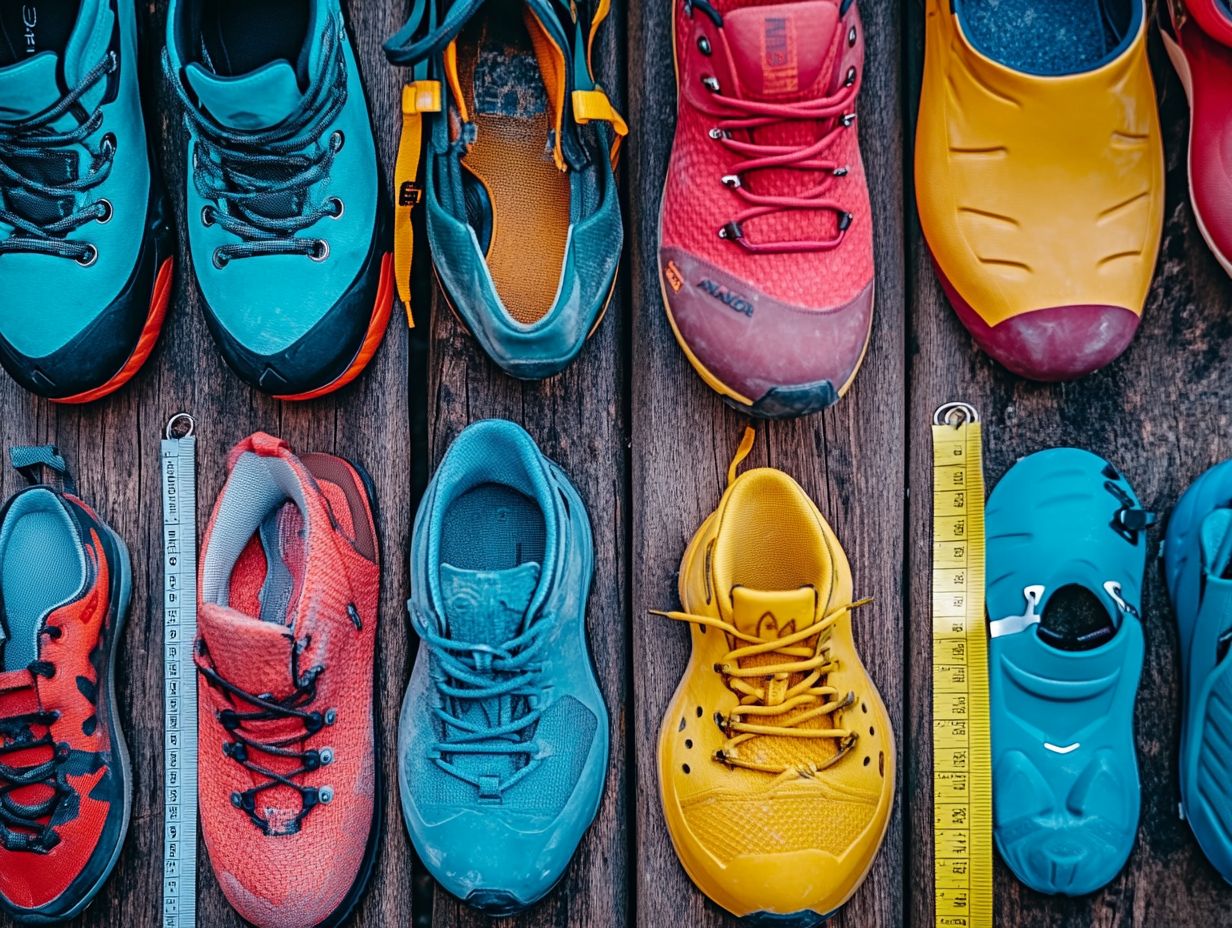
- Comfort should be a top priority when choosing climbing shoes for beginners, as it can greatly impact your performance and enjoyment while climbing.
- Look for climbing shoes with good grip and traction to ensure stability and safety while scaling different types of terrain.
- Versatility is important for beginners, as it allows for experimentation with different types of climbing without having to invest in multiple pairs of shoes.
1. Comfort is Key
When selecting the best beginner climbing shoes, comfort takes precedence. It directly impacts your performance and enjoyment on both indoor and outdoor routes.
This allows you to concentrate on perfecting your climbing techniques rather than battling discomfort. Finding the right balance between materials whether synthetic or leather is essential for achieving that comfort.
Synthetic shoes often offer a more forgiving fit, while leather can adapt beautifully to your foot over time, though they may require a brief break-in period. Aim for a snug fit that avoids painful pressure points.
A proper climbing shoe fit enhances your stability and control. For those embarking on their climbing journey with beginner climbing shoes, ensuring that your shoes are comfortable not only boosts your confidence but also helps you adapt quickly to various climbing techniques and styles.
This way, each climb feels more enjoyable and significantly less intimidating.
2. Good Grip and Traction
The grip and traction that climbing shoes provide are crucial for both indoor climbing and outdoor climbing. This allows you to securely position yourself on a variety of surfaces, enhancing overall climbing shoe performance.
High-quality rubber is a game changer in this regard; it influences not only how well you adhere to holds but also your ability to execute precise movements. When you consider different climbing techniques, the subtleties of traction become even more essential.
Well-designed climbing shoe options made from durable yet flexible materials can significantly boost your confidence and execution on challenging routes. Different types of rubber, like sticky versus stiffer compounds, offer unique advantages tailored to specific climbing environments.
For instance, softer rubber shines on granite, while firmer options may be more suitable for sport climbing on artificial walls. Material selection is crucial in optimizing your grip and performance.
3. Versatility for Different Types of Climbing
The versatility of climbing shoes is essential for accommodating various climbing disciplines, from bouldering to multi-pitch climbing and gym climbing. Selecting shoes that can adapt to different environments and conditions is vital.
If you’re venturing into indoor climbing, consider shoes with a softer rubber compound for optimal grip on artificial walls. If you crave the rugged experience of outdoor sports, you’ll want climbing shoe options that offer more stiffness and durability to tackle rough terrains.
There are specialized options available as well aggressive shoes designed for precise foot placements and neutral styles that provide comfort for those extended stays on the rock. By understanding the nuances of each climbing shoe type, you can make informed decisions that enhance your performance.
Get ready to enjoy a more fulfilling climbing experience!
4. Proper Fit and Sizing
Proper fit and sizing are paramount when selecting climbing shoes. An appropriate fit boosts performance and ensures you feel comfortable and supported during your climbing sessions.
To measure your foot size accurately for climbing shoes, understand your foot dimensions, including both length and width. You can trace your foot on paper or use a measuring device to compare your measurements against brand-specific sizing charts.
Given that sizing can vary significantly between brands, trying on various models is crucial, especially for newcomers. A snug fit facilitates optimal power transfer to the climbing surface, making accurate climbing shoe sizing even more important.
Ultimately, taking the time to assess different climbing shoe sizes ensures you find shoes that fit well and enhance your overall climbing experience.
5. Support and Protection
Support and protection in climbing shoes are vital for safeguarding your feet and enhancing your overall climbing performance. Well-constructed climbing shoes offer the necessary support whether you’re just starting out or taking on more challenging routes.
Good design is key to achieving the perfect balance of stiffness and flexibility, allowing you to maintain optimal foot placement on tricky holds. If you’re drawn to shoes with a pointed toe design, it s important to understand how these styles enhance your precision and power, facilitating better force transfer to your toes.
Protective features like reinforced toes and durable rubber significantly reduce the risk of common injuries such as bruising or cuts. This ensures you can focus entirely on your ascent, free from the distractions of discomfort or vulnerability.
6. Durability
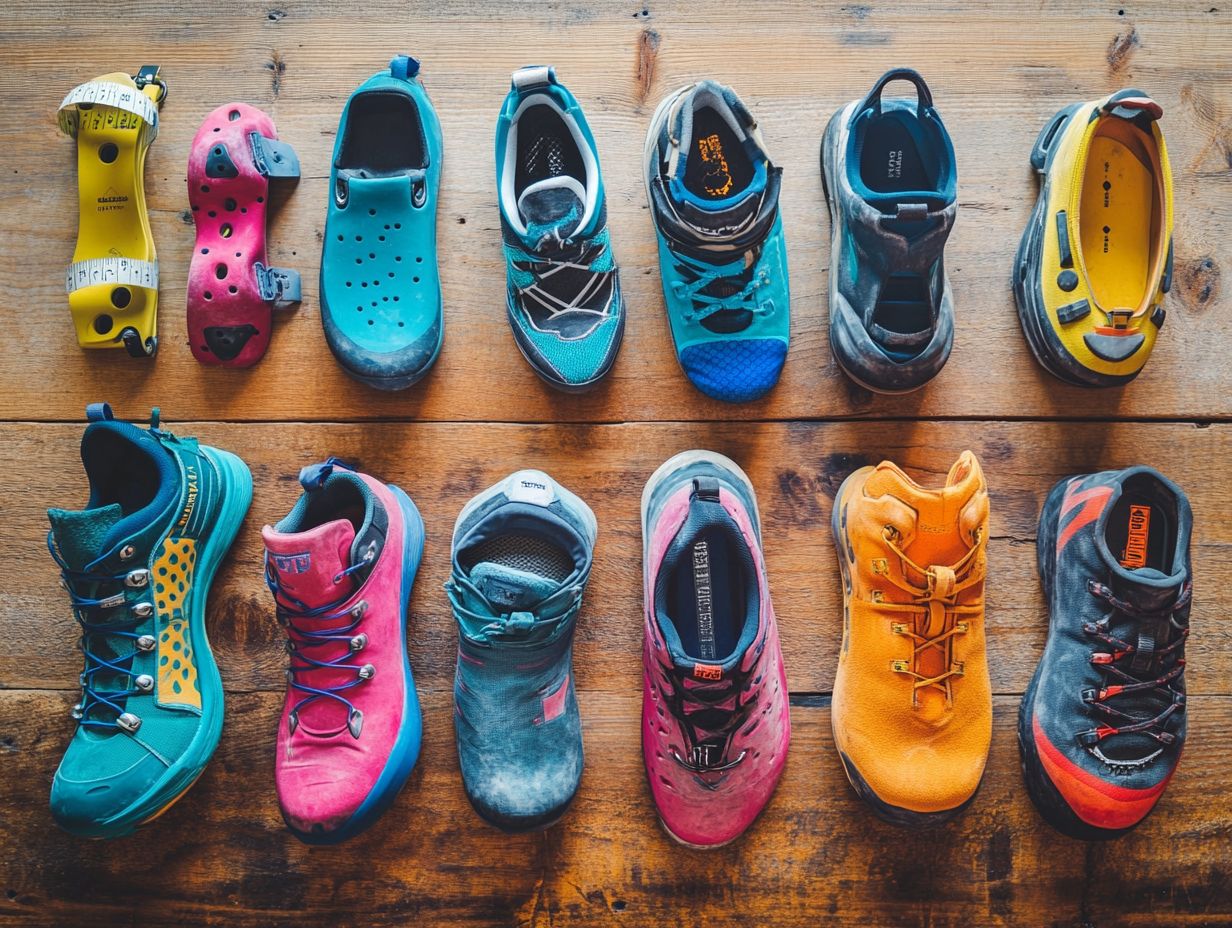
Climbing shoe durability is a vital factor for you as a climber, especially when considering price for the best budget climbing shoe. High-quality materials and construction significantly contribute to the longevity of your shoes, making them a worthwhile investment especially if you’re a beginner seeking affordable options without sacrificing quality.
The durability of your climbing shoes largely depends on the materials used in the upper, lining, and sole, with rubber being a key player in performance and wear resistance. It s important to recognize that different rubber compounds can greatly impact not only grip but also the shoe s lifespan during rigorous use across varied terrains.
When evaluating your climbing shoe options, take the time to compare the thickness and quality of the rubber outsoles. Thicker materials generally hold up better against wear. Additionally, checking customer reviews and performance ratings will offer valuable insights into how specific models perform over time, enabling you to make informed decisions for your climbing adventures.
7. Breathability
Breathability in climbing shoes is a crucial feature to consider, particularly for indoor sports. It plays a significant role in regulating temperature and moisture, ensuring that you enjoy a comfortable fit during those extended climbing sessions.
This thoughtful design aspect impacts how well the footwear accommodates various foot shapes and sizes, ultimately allowing for optimal performance. The materials you choose synthetic fabrics or leather each come with their own unique breathability traits. Synthetic options often provide superior moisture-wicking abilities and dry quickly, making them ideal for humid environments. On the other hand, leather may offer a snugger fit over time but might not manage moisture as effectively initially.
A well-ventilated climbing shoe significantly reduces sweat buildup, enhancing your overall climbing comfort while you ascend. For climbers eager to push their limits, breathability becomes not just a luxury but an essential element for maintaining focus and performance on those challenging routes.
8. Easy to Put On and Take Off
The simplicity of putting on and taking off climbing shoes is a crucial feature that can significantly enhance your climbing experience, especially as a beginner. You ll often find yourself transitioning between different routes, which demands quick adjustments.
This is where the choice of climbing shoe types of closures becomes essential. Velcro designs allow for rapid adjustments with just a pull and press, enabling you to make swift changes between routes without wasting precious time. In contrast, slip-on styles offer a snug fit that many climbers appreciate for the added sensitivity on the rock, which helps you achieve better foot placement.
Each option has its own benefits, impacting not just your climbing shoe comfort but also your performance and confidence on the wall. By understanding these differences, you can make informed decisions about footwear that aligns perfectly with your unique climbing style and needs.
9. Affordable Price
Finding affordable climbing shoes is essential for beginners venturing into the climbing world. Striking a balance between cost and quality can greatly influence your initial climbing shoe experience.
With prices ranging widely, it s easy to feel overwhelmed when selecting the right pair within your budget. Climbing shoes can start as low as $50 and soar to over $200.
Fortunately, the best budget options often don t skimp on key features, offering a decent fit and grip while remaining beginner-friendly. When searching for your ideal pair, keep an eye out for models that provide:
- A snug yet comfortable fit
- High-quality rubber
- A moderate downturn
- Toe rubber
These elements are crucial indicators of a reliable shoe. To get the most bang for your buck, shop during seasonal sales, consider gently used options, and consult local climbing gyms for their recommendations on budget-friendly brands. Additionally, check out the best climbing gear for beginners for more tips on making an informed purchase.
10. Brand Reputation
The brand reputation of climbing shoe manufacturers is vital in determining the quality and reliability of their products. Established names like Butora, La Sportiva, and Scarpa are often the go-to choices for both novices and seasoned climbers.
This preference for trusted brands spans various climbing shoe types, each showcasing unique strengths. For instance, La Sportiva is frequently praised for its precision fit and stellar performance on technical routes, making it a favorite among serious climbers.
Scarpa, on the other hand, is celebrated for its comfort and versatility, appealing to those who enjoy sport and trad climbs, as well as bouldering.
Butora carves out its niche with innovative designs and affordability, resonating well with entry-level climbers. When you choose shoes from these manufacturers, you’re not merely selecting footwear; you’re investing in a legacy of craftsmanship and reliability that can significantly enhance your climbing experience.
11. Beginner-Friendly Features
Beginner-friendly features in climbing shoes are crucial for new climbers seeking to build confidence and enhance their skills. Focus on aspects such as comfort, ease of use, and supportive designs that elevate overall performance.
Key foundational elements include flexibility, which allows your feet to move naturally, and supportive cushioning that reduces discomfort during extended wear. Experts recommend choosing shoes with a wider toe box to accommodate various foot shapes, enabling you to concentrate on your technique without the distraction of painful pressure points.
A flatter sole offers a stable base, fostering improved balance and control on the rock. Models like the La Sportiva TarantuLace or the Five Ten Anasazi VCS are highly recommended, as they perfectly blend these beginner-friendly features, making your climbing experience more enjoyable.
You can also look into climbing shoe reviews to find the best overall climbing shoe. Start your climbing journey today with the perfect pair of shoes!
12. Reviews and Recommendations
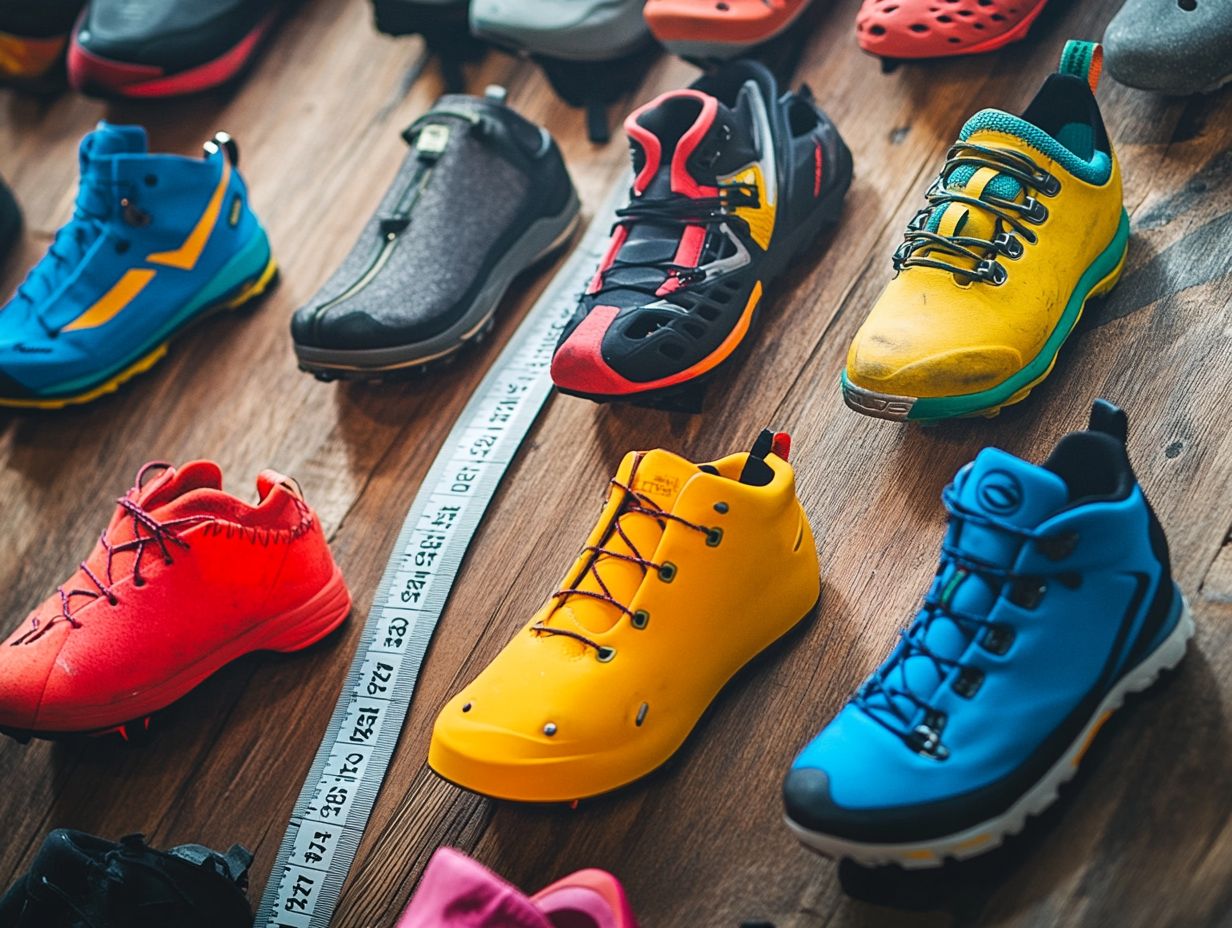
Climbing shoe reviews and recommendations are your essential guide, helping you make informed choices. They provide insights into the performance characteristics and fit of various options available in the market.
It s important to know how to interpret these reviews. Different climbers prioritize different aspects some seek comfort, while others value stiffness or specific climbing styles.
When evaluating climbing shoes, consider key criteria like material, sole thickness, and closure systems. These factors play a significant role in your performance.
Compare different brands and models to find a pair that meets your unique needs, ensuring an optimal experience on the rock.
Pay attention to user experiences shared in climbing shoe reviews. These real-world insights often reveal details that product descriptions might miss, giving you a fuller picture of what to expect from your footwear.
13. Fit for Personal Climbing Style
Choosing climbing shoes that match your personal climbing style is vital for both performance and comfort. Different shoes cater to various techniques and preferences, making it important to choose wisely.
Understanding climbing styles like trad, sport, bouldering, or alpine can greatly influence your shoe choice. For example, if you re a sport climber, downturned shoes can help you find precision on small footholds.
Trad climbers often prefer a more relaxed fit for comfort on long climbs. If bouldering is your focus, shoes with rubber soles can provide maximum grip for powerful moves.
Take a moment to assess your climbing habits and the environments you tackle. This way, you ll choose shoes that enhance your techniques and overall experience.
14. Available Sizes and Colors
Size and color options in climbing shoes are important for climbers. They ensure a proper fit and allow you to express your personal style.
Finding the right size is crucial, as foot shapes vary among individuals. A well-fitting shoe improves grip and stability, allowing you to focus on technique without discomfort.
If you re new to climbing, you might be surprised by how color choice can impact your confidence. Opting for brighter hues or unique patterns can make your experience more enjoyable in the climbing shoe market.
When both size and color reflect your identity as a climber, your journey up the wall becomes more fulfilling. Embrace the climbing disciplines you enjoy.
15. Return and Exchange Policy
A clear return and exchange policy for climbing shoes is important, especially if you’re a new climber trying to find that perfect fit.
The climbing shoe market can feel overwhelming, with brands showcasing distinct styles and sizing differences. A good return policy builds confidence and encourages exploration without the fear of being stuck with ill-fitting shoes.
To lower the chances of needing to exchange shoes, accurately measure your feet, considering both length and width. Try on shoes with the socks you ll be wearing, as this affects fit.
Understand the shoe’s intended use whether for sport climbing, bouldering, or traditional climbing. This knowledge ensures the pair you choose enhances your comfort and performance through the right features.
What to Look for in Climbing Shoes for Beginners?
When selecting climbing shoes as a beginner, it s essential to focus on key factors like fit, performance characteristics, and features that enhance both comfort and functionality. A properly fitting shoe minimizes discomfort and offers the support you need, allowing you to concentrate on refining your climbing technique instead of being distracted by ill-fitting gear.
Don t underestimate comfort metrics such as padding and breathability, as they significantly impact your experience on the wall. Durability is another critical consideration; opting for materials that can withstand various terrains and conditions ensures that your investment will endure through countless training sessions.
The shoe’s design should align with your primary climbing activity, whether you’re bouldering or sport climbing. This alignment helps build your confidence and nurture your skill development as you embark on this exciting climbing journey, particularly with slip-on shoes or those featuring straps that stick together. For beginners, choosing the right climbing gear is crucial for a successful start.
Frequently Asked Questions
What are the best climbing shoes for beginners?
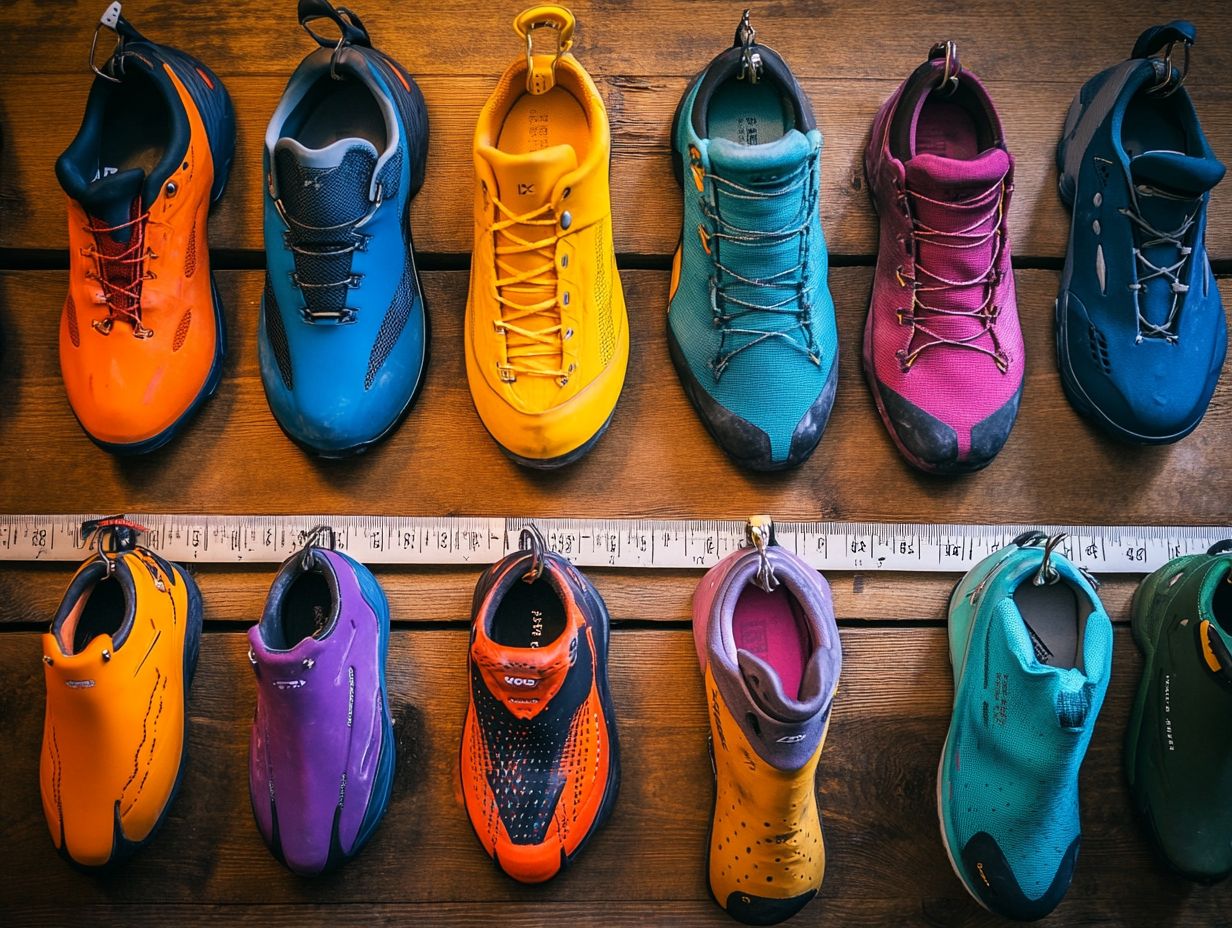
The best climbing shoes for beginners are comfortable and have a flat sole, making it easier to learn proper foot placement and technique. They should also have a neutral shape, allowing for a wider range of foot sizes and shapes.
What features should I look for in climbing shoes for beginners?
When choosing climbing shoes for beginners, seek a comfortable fit, a flat sole, and a neutral shape. It’s important to consider the type of climbing you will be doing and choose shoes with appropriate features, such as a stiffer sole for outdoor climbing.
Do I need to spend a lot of money on climbing shoes for beginners?
No, you don’t need to spend a lot of money on climbing shoes for beginners. Many affordable options offer the necessary features. It’s more important to find a comfortable and properly fitting shoe than to choose the most expensive option.
Can I use my regular athletic shoes for climbing?
While regular athletic shoes may seem like a good option for climbing, they are not designed for the specific needs of climbing and may not provide the necessary grip and support. It’s best to invest in a pair of climbing shoes for a safer and more enjoyable climbing experience.
What type of sole is best for climbing shoes for beginners?
A flat sole is ideal for beginner climbing shoes, as it allows for better foot placement and balance. It also helps beginners learn proper technique without relying on the shape of the shoe to hold their foot in place, making them a great choice among climbing shoe options.
How do I know if my climbing shoe fit is right?
Your climbing shoes should fit snugly without any extra space, but they should not be so tight that they cause discomfort or pain. Make sure your climbing shoes feel comfortable! It’s also important to try on climbing shoes in person and walk around in them to ensure they fit properly before purchasing.
When assessing your options, consider the climbing shoe features that cater to different climbing styles, from trad climbing to bouldering. For those transitioning from beginner to intermediate, a solid beginner climbing shoe guide can assist in making the right choice for climbing shoe performance characteristics. Don’t miss out on the best climbing shoes check out different climbing shoes to find the best prices and options tailored to your needs!

